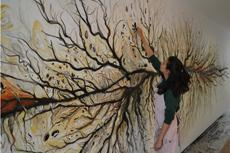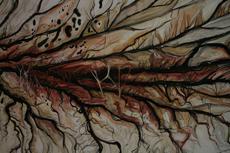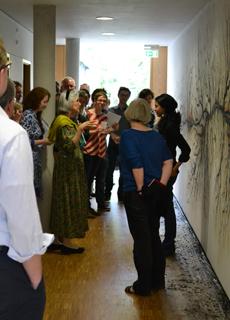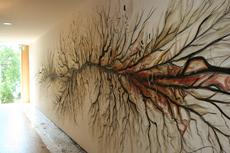Umbraphile or shadow walker, one who is addicted to the glory of total solar eclipses, noctcaeladors defined as those with a strong interest in, and psychological attachment to the night sky—who are these individuals who watch the stars and invest time and resources in the activity? Why do they continue to chase eclipses and other celestial phenomena across the country and sometimes the world? Why do they continue to do the work of observation, conduct the tedious numerical reduction of orbital elements, and find only private sources for publishing their material? What draws them to the night sky? What do they see when they gaze at it night after night? What are the landscapes where such encounters take place? My artistic practice over the past few years has been rooted in science, manifesting itself through content, concept, media and technology. The work has taken many directions, driven sometimes by an exploration of the self organization of pattern, morphology and morphological relationships to a more recent interest in processes of emergence and emergent behaviour.
My current research explores the interface between art practice, specifically drawing and astronomy through the lens of metaphor. Parts Unknown is the result of a four month residency at the Max Planck Institute for the History of Science March–June 2012 in Department II, Ideas and Practices of Rationality.
I joined the Amateur Astronomers Association (AAAD) in New Delhi in July 1999. At the time I thought it might be the closest thing to a science fiction convention in the city. What I discovered was a diverse, dynamic group of physics and astrophysics students, photographers, entrepreneurs, academics and dreamers, each uniquely individual. What united them was a common love for stellar phenomena, a deep respect for nature, and a desire to share the joy of observing and chasing, both with other amateurs and with the general public.
On the 22nd of July 2009, India witnessed the longest total solar eclipse of the twentyfirst century, not to be surpassed until 13 June 2132. In spite of the fact that cloud cover and rain prevented our viewing of the eclipse, the experience of being in Patna, Bihar on the roof of the Patna Planetarium during those 7 minutes of totality proved to be a turning point.
Beginning in July 2009 and through August 2010, I traveled back and forth across the country with different individuals to witness a specific stellar event or visit a particular astronomical site. From Patna for the longest total solar eclipse, Varkala, Kerala for the Annular Eclipse, I travelled to some of the most hallowed sites of Indian astronomy, the Indian Astronomical Observatory at Hanle, Ladakh and the Giant Meter Wave Radio Telescope array just outside Pune. Part of this research was undertaken under the Sarai Associate Fellowship of the ‘City as Studio’ initiative of the Sarai Programme at CSDS, Delhi between February–November 2010.

Fig. 2: Rohini Devasher: Parts Unknown (2012).
All these trips were extraordinary, these sites, hidden away from most civilization, far from any towns and villages are almost symbolic of the individuals that populate them. The astronomers too escape the city as often as possible to find the stars, unspoiled and comparatively untouched. I realized while in Leh and Pune that I do a very similar thing right here in Delhi. I drift through or rather across the city, never really touching down completely. Astronomy offers that form of escape, offers these sites of pilgrimage; (I can call an eclipse chaser’s journey nothing else) far from people and place.
Stories, conversations and histories … came together in a slowly building audio chronicle of the almost obsessive group of people whose lives have been transformed by the night sky.
As an amateur astronomer and an artist, the process was also an exercise in self reflexivity. Where did I position myself within the project, or perhaps where did astronomy position itself within my practice? What did it mean to be both participant and observer?
Beyond the romance of being there at that moment, how could one take this further into perhaps another area of inquiry? Perhaps free it from its origins all together?
“for that which we imagine must be either something already seen or a composite of things and parts of things seen at different times; such are sphinxes, sirens, chimeras, centaurs etc”
(Galileo Galilei, Sagredo quoted from the Dialogue Concerning the Two Chief World Systems [Dialogo sopra i due massimi sistemi del mondo], 1632)
In Imagining the Unimaginable (2002), Ladina Bezzola Lambert describes in detail, the role and importance of metaphor in the poetics of early modern astronomy. In 1610 Galileo published his extraordinary Sidereus Nuncius, the first scientific treatise based on his observations of the Moon, the stars and the moons of Jupiter through a telescope. His drawings describe a Moon pitted and scarred, an astonishingly irregular surface.
“this lunar surface, which is decorated with spots like dark blue eyes in the tail of a peacock, is rendered similar to those small glass vessels which, plunged into cold water while still warm, ‘crack and acquire a wavy surface, after which they are commonly called ice-glasses.”
As Lambert points out, the images Galileo conjures to describe the lunar world are themselves a species of ‘chimera.’ They are one thing, standing in for something else, pushing the limits of the known and the imagined.
We might apply the same argument to the role of visual representation within astronomy today. How do current techniques of visualization capture and then translate phenomena that are millions of miles away? How are these ‘images’ seen, treated, understood and what might they teach us about abstraction?
Peter Galison and Caroline A Jones in their introduction to Picturing Science Producing Art (1998) discuss Bruno Latour ways of pointing at absence.
“Latour insists, the dynamic of this set of symbols (and symbols of symbols) does not function by directly invoking the final referent, but rather by a complex process of mediation that is itself the bearer of meaning”
In rendering the strange conceivable, projection has its limitations, as with Galileo’s description of the dark spots on the lower horn of the moon. But studies on creative problem solving have shown that one way of gaining new perspectives on a problem is to juxtapose it with something completely unrelated, thereby making the familiar … strange.

Fig. 3: Rohini Devasher working on the mural Parts Unknown (June 2012).
Parts Unknown is the fifth in a series of large site specific, wall drawings that are an exploration of landscape as a living entity, of what British artist Paul Morrison has described as ‘cognitive landscape’: or landscape looking back. Each drawing was done on site over a period of 5 to 90 days, the wall in each case was custom built. The five sites include the Winchester School of Art, 2004 (UK), Vadhera Art Gallery, 2008 (New Delhi), Project 88, 2009 (Mumbai) and the Kiran Nadar Museum 2012 (Noida).
This fifth iteration at the Max Planck Institute for the History of Science however, is more specifically an exercise in frame-switching between different scales—between microcosm and macrocosm. In trying to understand the role of the imagination in comprehending and translating remote spaces and topographies I searched not so much for correspondence as for continuity between the two systems.
The drawing is a jigsaw constructed and stitched together from a variety of diverse ‘raw materials’ or ‘sources.’ Through the process of the drawing, done on site over a period of 12 days, the relationship between the drawing and the forms from which they are derived is gradually blurred until all real similarity vanishes. The textural, structural character of the original forms remain, but via a process of assemblage, agglomeration and juxtaposition coalesce into something new.

Fig. 4: Detail of the mural Parts Unknown.
Parts Unknown was built by the layering of small marks. An exploration of an unknown landscape of undetermined topography, it tries to sketch a miniscule cosmography. It becomes a metaphor for the natural world, by turns idyllic, stark, uncanny, threatening, and seductive.
The drawing began with an image of a river system. Remote sensed data that was then multiplied to branch across the surface. To this were added deltas and estuaries, cloud and glacier formations, objective information gathered at a variety of spatial scales. Details emerged, topographical maps with irregular radiating circles to mark mountains and hills. Small lakes and ponds scattered like spots across the wall.

Fig. 5: Rohini Devasher with Lorraine Daston and members of Department II (Ideals and Practices of Rationality) in front of the mural Parts Unknown.
We shift from one scale to another without disrupting continuity. The result is somewhat unclassifiable.
The drawing focuses on the interface between the positive and negative spaces, or the relationship of forms that share edges. The completed drawing presents you with a mental choice of one of three (or more?) interpretations, each of which is valid:
1. The dark lines running across the wall is a river system with the spaces around it, an aerial view of the surrounding topography.
2. The dark lines are cracks in the wall and you stand looking at or ‘into’ something immediately before you, something that threatens to erupt or explode.
3. You are looking deep into some form of biological branching systems, neurons, blood vessels, veins, and so on, where the dark areas are wounds across ‘a body.’

Fig. 6: View of the mural Parts Unknown during the 12 days of drawing.
These interpretations cannot co-exist, cannot be perceived at one time, they fluctuate, which creates a sense of vertigo. This sense of instability is further heightened by the fact that the drawing exploits the basic procedure of adding up heterogeneous elements within habitually incompatible frames of reference, without trying to synthesize them. These bits and parts can be combined but this combination is not—and never will be—a stable combination. Hybridization is the only possible operation and at its best it results in an enigma that cannot be unraveled.
